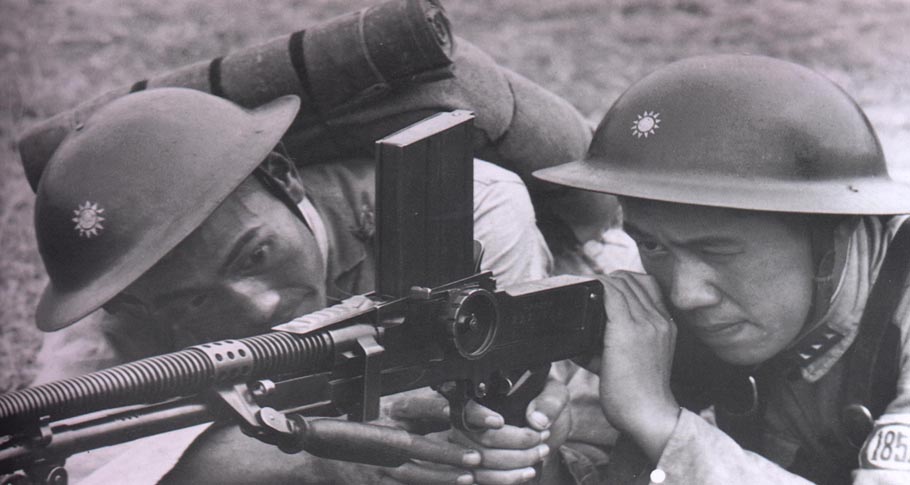
The Czech-designed ZB-26 was China’s favorite light machine gun during the war with Japan in the 1930s and 1940s. Below is the first of two articles on this legenday weapon, excerpted with kind permission from the newly published book China’s Small Arms of the 2nd Sino-Japanese War (1937-45) written by Bin Shih and edited by Stanley Zielinski. For much more detail, not just about this gun but dozens of other weapons used in the Chinese army during World War Two, the book is a gold mine and warmly recommended. Click here for more information.
In 1920, the Czechoslovak gun designer Vaclav Holek of the Praga Zbrojovka (Prague Armory) started working on a new light machine gun design. He later joined the Brno Factory to complete his design. The experimental version was called Lehky kulomet Praga vzor 26 and was successfully tested by the Czechoslovakian Defense Ministry. The Czechoslovakian Army adopted it as the Zbrojovka Brno Vzor 26 (ZB-26 or Vz 26). China purchased large quantities of this model from Brno and this was also the light machine gun widely produced during the war.
Between 1927 and 1939, Brno records show that there were 32,272 ZB-26s shipped to China. Among these, 17,163 were procured between 1937 and 1939. The last batch of 100 guns was shipped out in April, 1939. Guangdong Province purchased 1,000 and the Northwestern Army purchased 1,332 between 1930 and 1932.
The first successful copy in China was accomplished by the Taku Naval Dockyard in 1927. After Taku, many arsenals in China started producing ZB-26. It remained the primary light machine gun after the war, into China’s civil war and beyond. In 1934, the Ordnance Office decided to adopt the ZB-26 as the standard light machine gun: “There were many copies produced in China, the Taku ones were the best,” a report from the Chinese Ordnance Office said in 1934. “However, due to the lack of templates and standard drawings, parts were not standardized and interchangeable. The steel used was also below standard.”

In 1934, the Ministry of Finance ordered 5,000 ZB-26s from Brno. The Ordnance Office had (hoped) to obtain the drawings and gauges. However, since the order was only for 5,000, the manufacturer was not willing to comply. The only thing received was a set of the acceptance gauges and even that took a lot of negotiation.
Subsequently, the Ordnance Office sent two engineers and one technician to Brno to “supervise” the contract production. They were secretly ordered to carefully observe the production processes and procedures. These people returned and started the design drawings. Some of the drawings were based on the gauges on hand and others had to be recreated. When they were completed, the drawings were forwarded to the Gongxian Arsenal. It was estimated that the production could start in a year’s time.
Production began in the Gongxian Arsenal, but output was fairly limited – the record shows that they could only produce a few hundred guns a year. [China approached Brno for a formal license production agreement, but Brno rejected the proposal after the outbreak of full-scale war with Japan in the summer of 1937. China toyed with the idea of switching to the Danish Madsen machine gun, but eventually changed back to the ZB-26, domestically manufactured.]
The 21st and 51st arsenals were the two most important ZB-26 producers during the war. The 51st Arsenal, located in Yunnan, started production in June 1941. Total production for the year was 450 guns. The 51st Arsenal merged with 22nd Arsenal in 1942 and formed the 53rd Arsenal, which became the largest producer during the war. The average output was 300 guns per month, with the total production during the war 14,920 guns.
I see why chinese liked them so much! And the brits, who also made guns (canadian Inglis-made Bren guns chambered in 8 mm Mauser, but due to the changes needed for the gun to accept the rimless Mauser cartridge instead of the .303 british, those “Brens” were actually more Zb. 26 than Brens) for the Nationalist chinese Armed Forces. The chinese used: 8 mm Mauser Bren/Zb. 26, their local copy “Type 26” (also a later version chambered in soviet 7.62×39), and the Type 96/Type 99 japanese LMGs -captured ones- being these copies of the czech Machine gun.